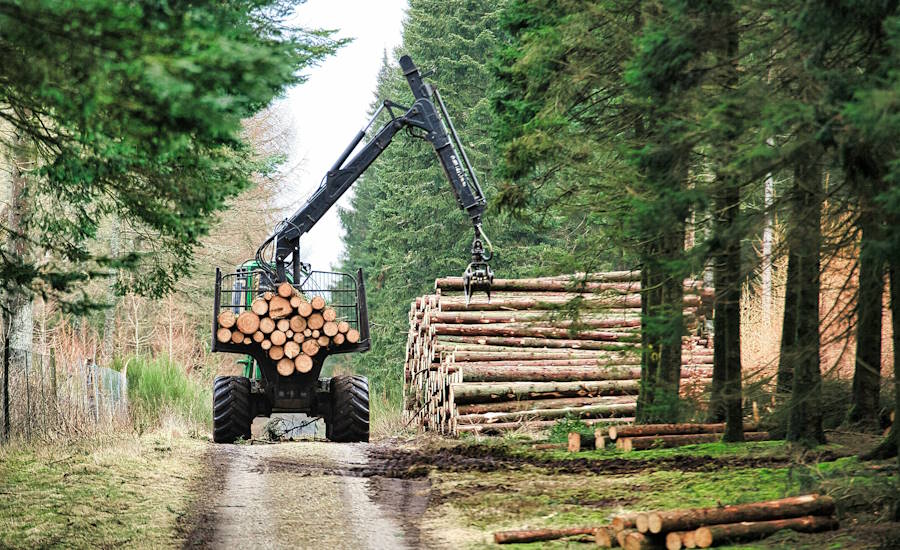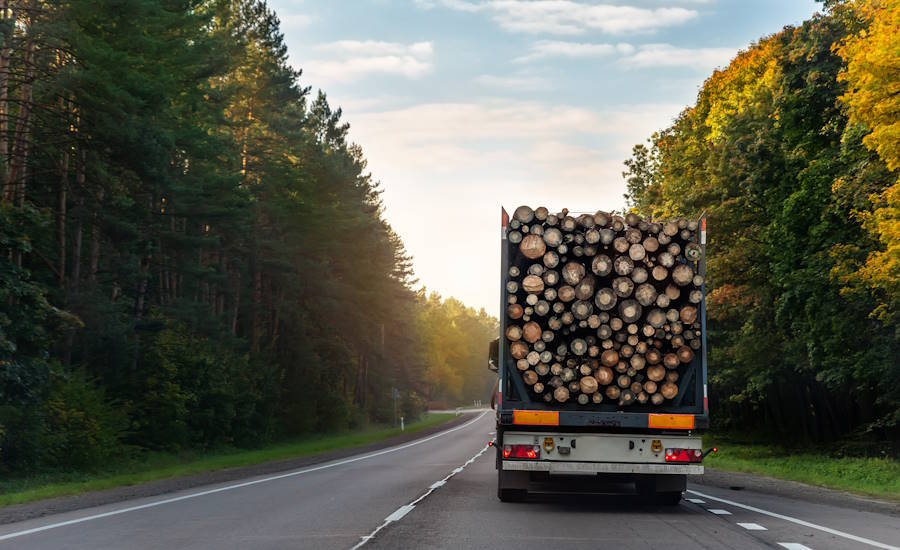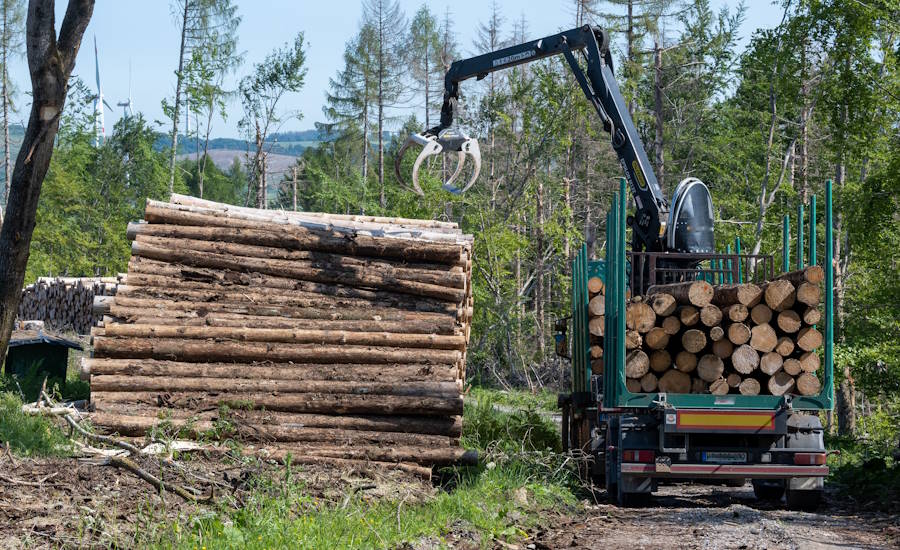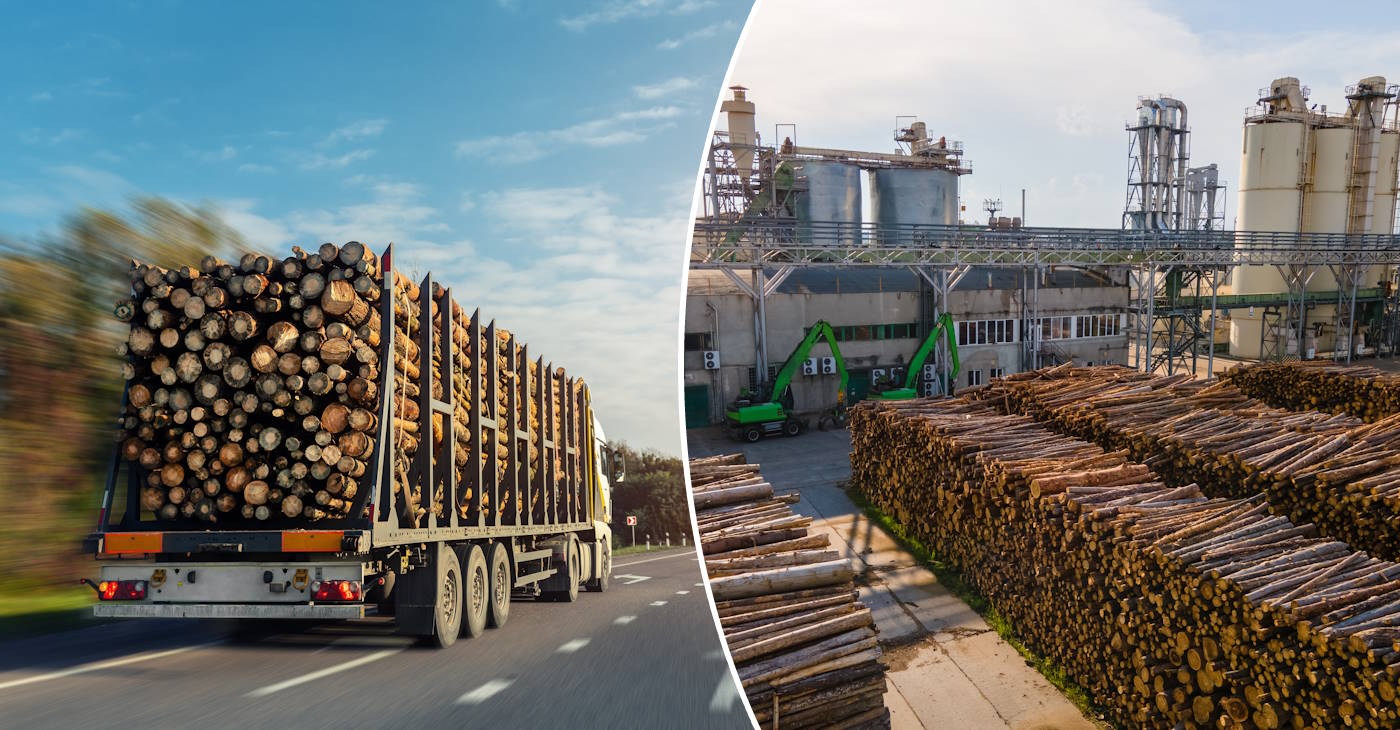How much timber can a logging truck carry? The exact capacity varies by region and vehicle configuration, but a typical logging truck operating under standard highway regulations can often transport between 20 and 40 metric tons of timber per load. In some regions with specialized vehicles and favorable regulations, these trucks may carry closer to 50 metric tons. Ultimately, the precise payload depends on factors such as axle load limits, trailer length, local weight restrictions, and the density of the wood being hauled. This substantial carrying capacity makes logging trucks an essential link in the supply chain, efficiently moving felled timber from remote forests to sawmills and other processing facilities, and with a crane attached directly to the logging truck, the process is simplified even more! We’ll take a look at this, and more, down below!
The basics: What is forestry?
Forestry refers to the science and practice of managing forests and related natural resources for a variety of purposes, including timber production, conservation of biodiversity, recreation, and carbon sequestration. Foresters and forest technicians employ a wide range of skills: from understanding silviculture (the cultivation of trees) to mastering harvesting techniques and reforestation procedures. In addition, forestry encompasses research on soil health, wildlife habitats, and sustainable management practices designed to balance economic interests with ecological considerations.
Throughout history, forests have supplied communities with raw materials for shelter, fuel, and construction. Modern forestry, however, has evolved to prioritize sustainable yield, ensuring that the volume of wood harvested does not exceed the rate at which trees can regenerate. This approach often involves selective cutting, clear-cutting in specific areas followed by replanting, and continuous monitoring of forest growth to maintain long-term forest health.
Which machines are used for forest harvesting?
Professional forestry operations rely on various specialized machines to fell, delimb, and prepare logs for transport. One of the most notable is the harvester, a sophisticated piece of equipment that combines cutting, debarking, and bucking functions. Equipped with an articulated arm and a cutting head, the harvester can grip a tree, saw it at the base, strip off branches, and cut the trunk into manageable lengths—all in one streamlined process.
Another essential machine is the forwarder, responsible for gathering logs from the forest floor after the harvester cuts them. Forwarders load the logs onto their own bunk area and carry them to a roadside landing or staging area. Alternatively, some operators prefer a timber trailer with a crane attached to a tractor or other prime mover, which can function similarly to a forwarder but is often more versatile for smaller or mixed-use forestry operations. Skidders are also common; they drag or “skid” whole trees or logs across the ground. Each machine type is selected based on terrain, the volume of timber to be harvested, and the scale of the operation.
How timber is transported out of the woods – after being harvested
Once the logs are felled and cut to the desired lengths, they must be moved from the felling site to a collection point, often referred to as a landing or roadside deck. In mechanized operations, the forwarder (or timber trailer with crane) takes care of this short-distance transport. The logs are then stockpiled and made ready for loading onto trucks. For long-distance transportation to sawmills, paper mills, or export terminals, the logging truck with crane or a conventional logging truck (sometimes loaded by an external loader) becomes the critical piece of equipment.
In less mechanized settings or regions with steep terrain, cable yarding systems and aerial methods (such as helicopter logging) may be used to minimize ground disturbance. Regardless of the method, the goal remains the same: to efficiently, safely, and sustainably bring timber from the forest to the processor.

Forwarder vs timber trailer with crane
A forwarder is a specialized machine built exclusively for forestry tasks. It features an operator’s cab, an articulated chassis, and a loading crane that places logs onto its integrated bunk. Forwarders are designed for rugged forest conditions, boasting robust tires or tracks and high ground clearance to navigate uneven terrain. Their primary advantage lies in efficient off-road travel and self-loading capabilities.
A timber trailer with crane is typically an attachment to an agricultural or other tractor, offering a modular solution for smaller-scale operations or mixed farms. While these trailers do not always match the payload capacity or off-road prowess of a dedicated forwarder, they can be more cost-effective for landowners who need a versatile vehicle capable of multiple tasks. The crane’s capacity on these trailers varies but generally ranges from a few hundred kilograms up to several tons, depending on model and design. This flexibility makes them attractive for part-time forest owners or those who harvest moderate amounts of wood.
Experience the many advantages you too, with a timber trailer and crane! FTG Mowi is the number one choice if your looking for heavy duty quality stuff! Their range includes both forestry trailers, cranes and other must-have accessories, to make your day in the forest THE BEST!

What’s a logging truck, with our without crane, when discussing forestry?
A logging truck is a heavy-duty vehicle specifically adapted to transport logs from forestry operation sites to processing facilities, such as sawmills or pulp mills. Many configurations exist, but the most common design includes a truck chassis with a pivoting semi-trailer, fitted with bunks or bolsters to hold and stabilize loads of logs. In some cases, these trucks are set up as rigid vehicles with a trailing pup trailer. Logging trucks are built to withstand heavy loads, rough roads, and demanding conditions. They often have reinforced frames, specialized suspension systems, and traction aids, such as multiple-driven axles.
When referring to a logging truck with crane, we typically mean a self-loading variant equipped with a hydraulic crane mounted behind the cab or at the end of the trailer. This crane allows the driver to load and unload logs independently, eliminating the need for separate loading machinery. The convenience of a crane-mounted truck can significantly reduce operational downtime, especially in remote areas where dedicated loading equipment may not be available.
Off to the sawmill! This is how much logging trucks can carry
As noted at the beginning, a standard logging truck can often transport between 20 and 40 metric tons of timber. In regions with less restrictive road weight limits, vehicles may legally carry loads approaching or even exceeding 50 metric tons. Log size, wood density, and local regulations are all important factors. Softwoods like spruce or pine are typically lighter than hardwoods, meaning a trailer packed with softwood logs may carry a higher volume of wood for the same weight limit. The length and diameter of the logs also affect the stack configuration and overall hauling capacity.

Do all trucks have a log crane attached?
Not all logging trucks come equipped with a crane. In many large-scale operations, a separate loader or yarder is positioned at the landing to load freshly cut logs onto standard trucks. This can be more efficient for high-volume harvesting sites where log flow is continuous, and the loading process is centralized. Self-loading logging trucks are more common in smaller-scale or remote operations, where having a logging truck with crane simplifies logistics. The choice ultimately depends on cost considerations, loading speed requirements, and the specific demands of each operation.
Capacity of the hydraulic cranes
The hydraulic cranes mounted on self-loading logging trucks typically boast lifting capacities anywhere from 1 to 10 metric tons at varying reaches. The maximum capacity is always greatest when the crane is closest to its base; as the crane extends, its lifting capability decreases. Heavier-duty cranes can handle logs of substantial diameter and length, while lighter cranes are suited for smaller pieces. Advanced crane models may feature digital load monitors, telescopic booms, and remote-control systems that allow the operator to adjust positioning for precise loading.

The cost of timber
Timber prices fluctuate widely based on species, quality, grade, and regional market dynamics. Softwoods such as pine, spruce, or fir typically command lower prices than high-grade hardwoods like oak, maple, or walnut. In the United States, for example, softwood logs might average anywhere from USD 200 to USD 400 per thousand board feet (MBF). Premium hardwoods, especially those used in fine furniture or veneer, can exceed USD 700 per MBF. Across Europe, similar variations exist, with local markets further influencing the price depending on demand for construction, papermaking, or bioenergy. Timber grading systems also come into play, as higher-grade logs—free from knots, cracks, or rot—will fetch higher prices.
Harvested forests around the globe
According to reports from organizations such as the Food and Agriculture Organization (FAO) of the United Nations, the annual global production of industrial roundwood (which includes timber used in construction, paper, and other industries) consistently surpasses 2 billion cubic meters. If fuelwood and other forms of wood harvesting are included, that figure rises to well over 3 billion cubic meters annually. While harvesting rates differ by region—owing to factors such as forest management practices, market demands, and environmental policies—these numbers highlight the critical importance of sustainable forestry. Efforts to balance timber production with reforestation and conservation are central to ensuring the long-term availability of forest resources.
Let’s summarize! Forest to sawmill with a logging truck with crane
In short, the journey from standing tree to finished product is a complex, carefully orchestrated chain of events involving cutting-edge machinery and meticulous planning. Forestry operations integrate harvesters, forwarders, and timber trailers with cranes in the initial phases. At the final stage, specialized vehicles—often including a logging truck with crane—tackle the crucial task of hauling logs to sawmills. These trucks, which can carry upwards of 20 to 40 metric tons of wood, underpin the global timber industry by enabling rapid and efficient transport. Through robust engineering, strict safety standards, and adherence to sustainable forestry methods, the industry continues to meet the world’s wood demand while striving to protect and responsibly manage forest ecosystems for future generations.
Would you like us to write about a specific topic for our upcoming articles? Give us a shoutout through email and we’ll do our best to fulfill your wish.

